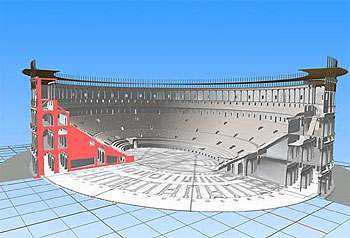| Architecture
Virtually Rebuilt, a Ruin Yields Secrets
Everyone knows that the Roman Colosseum is an architectural marvel. Built so that thousands of people could be ushered in and out in minutes, it is a testament to the genius of Roman engineering. Or is it?
By reconstructing the building with three- dimensional computer modeling and then virtually "walking through" it, researchers have discovered that in some sections the building may have had all the efficiency of a railroad-style apartment on the Bowery. The model reveals dark, narrow upper hallways that probably hemmed in spectators, slowing their movement to a crawl.
Such three-dimensional modeling is turning some of archaeology's once-established truths on their heads. Because 3-D software can take into account the building materials and the laws of physics, it enables scholars to address construction techniques in ways sometimes overlooked when they are working with two- dimensional drawings.
[read more]
----------
Cultural VR Lab

3D models of cultural sites bring the past to life for today’s students and tourists. The models can run on personal computers, be put on the World Wide Web, or be used as interactive illustrations on videos, DVDs or CD-ROMs. They can be used as "virtual sets" in film or television productions recreating a past event, providing a guided tour of a place that no longer exists, or creating the backdrop for plays or other works of fiction. Models can also be viewed in realtime in CAVEs and reality theaters such as UCLA’s new Visualization Portal.
[read more] |

